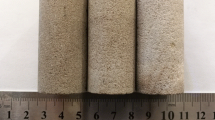Abstract
In sandstone, there is a trend between porosity (ϕ) and permeability (k). It is a linear relationship having the form log (k) = a + (b ϕ). The slope, intercept, and degree of scatter of the log(k) − ϕ trends vary from formation to another. These variations are attributed to differences in initial grain size and sorting, diagenetic history, cementation, clay content, pore geometry, and compaction history. In the literature, permeability and porosity modeling by using lab experiments was carried out by using unconsolidated sandstone, sand packs, or synthetic particles. Such models cannot be applied to predict flow properties of consolidated natural sandstone. Furthermore in these models, sand grain size, shape, and sorting factors were considered as the main factors that affect porosity and permeability. Hardly, any attention was paid to the confining pressure and the fraction of cementing material that bind the grain to form a coherent rock. If these two crucial aspects are not taken into consideration during the model development, the model cannot be applied to natural consolidated sandstone. The main objective of the present paper is to develop a new model for porosity versus permeability taking into account important factors such as sand grain size and sorting, compaction pressure, and concentration of cementing material that bind the sand grains. The effect for clay swelling or migration was however discarded, as the sand grains were washed prior to consolidation. The sand used in producing the sandstone cores was medium- to fine-sized well-sorted sand grains. The grain’s sphericity was measured to be in the range of (0.8–0.9) with little angularity. The fabricated cores have an average compressive strength of 5,700 psi, which is comparable with Bera sandstone strength. Also, the produced cores were stable in the fluid media as they were subjected to 300 °C to allow cementing material to be crystallized. The aspect of the present work was to analyze the dependence of both the permeability as well as the porosity on the variables of the present study that consist of grain size, cementation fraction, and the confining pressure. Using the experimental data, a linear relationship, in terms of each variable, was developed here that can eventually help researchers to fabricate cores with desired properties. The second step was to generate more general models to be used as references for scholars for further work in this research field. Nonlinear regression analysis was carried out on all the three variables of the present study to obtain two nonlinear correlations: one describes the behavior of permeability and the other describes porosity. In the third step, an advanced correlation that describes permeability versus porosity in a quantitative manner was developed by using nonlinear regression analysis. Permeability was studied accordingly as a function of all the three variables of the present study as well as porosity. This step represents the main objective of this paper.















Similar content being viewed by others
References
Ahmed U, Crary SF, Coates GR (1989) Permeability estimation: the various sources and their interrelationship, SPE-19604 in 1989 SPE annual technical conference proceedings, v. omega: Society of Petroleum Engineers, p. 649–662
Al-Homadhi ES (2001) Artificial sandstone cores production with a wide range of petrophysical properties. J King Saud Univ Eng Sci 14(1):95–118
Berg RR (1970) Method for determining permeability from reservoir rock properties. Trans Gulf Coast Assoc Geol Soc 20:303–3 17
Granberry RJ Keelan DK (1977) Critical water estimates for Gulf Coast sands. Transactions Gulf Coast Association of Geological Societies, pp. 63–66
Katz AJ, Thompson AH (1986) Quantitative prediction of permeability in porous rock. Phys Rev B 34(11)
Kolodzie S Jr (1980) Analysis of pore throat size and use of the Waxman–Smits equation to determine OOIP in Spindle Field, Colorado. SPE-9382 in 55th SPE annual technical conference proceedings: Society of Petroleum Engineers, p. 4
Krumbein WC, Monk GD (1943) Permeability as a function of size parameters of unconsolidated sand. Trans Am Inst Mining Metall Eng 151:153–163
Pittman ED (1992) Relationship of porosity and permeability to various parameters derived from mercury injection-capillary pressure curves for sandstone. Am Assoc Pet Geol Bull 76(2):191–198
Schlumberger (1988) Probing for permeability: an introduction to measurements. Tech Rev 36(1):6–20
Swanson BF (1981) A simple correlation between permeabilities and mercury capillary pressures. J Pet Technol 33:2498–2504
Thomson A (1978) Petrography and diagenesis of the Hosston sandstone reservoirs at Bassfield, Jefferson Davis County, Mississippi. Trans Gulf Coast Assoc Geol Soc 28:65 1–664
Timur A (1968) An investigation of permeability, porosity, and residual water saturation relationships for sandstone reservoirs. Log Analyst 9(4):8–17
Van Baaren JP (1979) Quick-look permeability estimates using sidewall samples and porosity logs, 6th annual European logging symposium transactions: Society of Professional Well Log Analysts, p. 19
Author information
Authors and Affiliations
Corresponding author
Rights and permissions
About this article
Cite this article
AlHomadhi, E.S. New correlations of permeability and porosity versus confining pressure, cementation, and grain size and new quantitatively correlation relates permeability to porosity. Arab J Geosci 7, 2871–2879 (2014). https://doi.org/10.1007/s12517-013-0928-z
Received:
Accepted:
Published:
Issue Date:
DOI: https://doi.org/10.1007/s12517-013-0928-z




